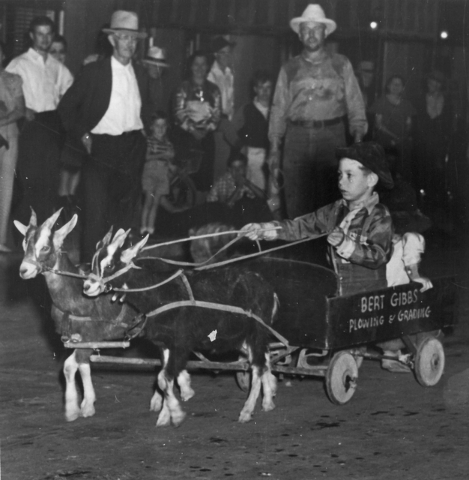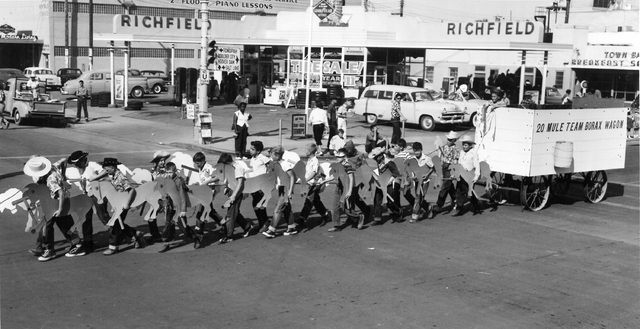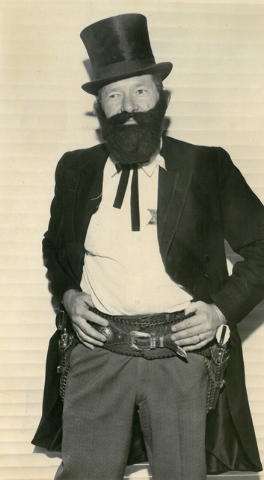Helldorado’s roots: Couple recall early years of event
The annual Helldorado Days Celebration & Rodeo is scheduled from May 14 to 17, but one person who won’t be there is 79-year-old Rollie Gibbs, who has attended the event since before he could walk.
“It’s just not the same event anymore,” Gibbs said. “It used to be the whole town turned out for it. There were three parades, everyone dressed up in Western outfits and there was some great local and national rodeo participants. These days, they don’t even have the right dirt in the arena.”
Nevertheless, promoters have high hopes for the cowboy-themed outdoor festival at Symphony Park, 361 Symphony Park Ave., set to include a nightly rodeo, a carnival, live music, exhibits, vendors, food and the Whiskerino contest for participants who have grown long or interestingly groomed facial hair.
In recent years, the parade has been limited to one night. This year, it is set to begin at 10 a.m. May 16, going north on Fourth Street from Gass Avenue and ending at Stewart Avenue. It is expected to last approximately two hours.
The event began in 1934 when an Arizona carnival promoter sought to capitalize on the audience of workers at Hoover Dam and the people who came to see the work being done in the middle of the Great Depression. The following year, city fathers decided to bring the event back, and eventually, the local Elks began organizing it.
Gibbs participated in several of the early Helldorado parades as a toddler. Many accounts of old Las Vegas and Helldorado include a picture of his brother, Bert “Sonny” Gibbs, driving a small wagon pulled by two goats. Rollie is sitting on the back.
“A lot of people thought that it was a girl on the back of the wagon, but that’s me,” he said.
By the time he was in high school, he was regularly driving big wagons in the parade.
“There were more wagons than drivers, so I’d take one down the line, and when I got to the end, I’d loop back quick to the beginning and pull another wagon down. Sometimes, I’d be in the same parade four times in a day.”
Over the years, Rollie Gibbs participated in Helldorado and other Elks events and eventually became a rodeo participant and judge, later organizing the Helldorado Queen contest. The contest started as a beauty competition but came to also involve horse riding skills.
Gibbs’ friend and classmate Naomi Lytle was crowned Helldorado Queen while they were in high school. She got married and moved out of town but returned a few years ago, and the two reacquainted themselves and discovered they were both single. They ended that status two years ago when they married. Naomi runs the Helldorado Queens Alumni group.
The two took time recently to look through some of the old Las Vegas Review-Journal Helldorado pictures and helped identify some participants. They even spotted themselves and a few family members.
A picture featuring a score of Helldorado Queen contests led Naomi to break out her old yearbook and her lists and notes concerning all of the Helldorado Queen winners over the years. The couple’s strongest memories were sparked by the photographs from the mid-1950s, when they graduated from high school.
A photo of a young cowgirl taking down a calf brought a smile and an exclamation of joy to Rollie’s face.
“That’s Sammy Fancher,” he said. “She’s the best roper I ever knew.”
The pair recognized several of their friends and classmates in a photo of college-aged people constructing a float at night. In the photo, they are positioning what appears to be a rebel flag, although the couple couldn’t be sure because the photo was in black and white.
“Oh, wait,” Naomi said, making the connection. “That’s the year UNLV started. It was the University of Southern Nevada back then.”
Another photo showed the completed float in the parade, with signs indicating that it was the school’s first float, including a sign reading, “Birth of a university April 29 1956.”
Many businesses and civic organizations entered floats in the parades. That included floats from all of the major casinos in town. Looking through the photos by year reveals the area’s transformation from a small rural community to a growing metropolis. Each year shows fewer floats being pulled by teams of horses and more by motor vehicles. Horse-drawn wagons are replaced by convertible cars. The floats, particularly the entries from casinos, became more elaborate, and fewer were populated by local teens, instead studded with showgirls and celebrities.
“I could see it going downhill way back then,” Rollie said. “It wasn’t so much about the community and history. It started being more about putting on a big show. When the town got bigger, we lost some of that community.”
The festival began as a rough-and-tumble event where local ranchers and businessmen could cosplay the Old West that some of them remembered or had learned about from their parents. The event continues as a peek at the Old West by people whose experience with cowboys comes from the silver screen.
One unusual aspect of the event was the Kangaroo Kourt (some years, the Kangaroo Court), in which local dignitaries were tried and put in the hoosegow (cowboy slang for jail) until someone paid their fine, which went to charity. To modern eyes, the photos of this process may appear unusual, with smiling politicians and other locals being driven into makeshift cells at gunpoint by smiling unofficial lawmen and women. There’s a lot of gun pointing in the photos, and a lot of cowboy outfits look more like flashy Roy Rogers costumes than gritty Billy the Kid daguerreotypes.
Roy Rogers was a fan of the event and filmed a movie there in 1946. It was titled “Heldorado” because Rogers didn’t want the word “hell” in one of his movies.
The Gibbses recently took a trip to visit family in Utah. On the way back, they visited a few of their old friends who had relocated to St. George, Utah.
“It’s a lot more like Las Vegas was in the old days up there,” Rollie said. “It’s a lot quieter and smaller. You know your neighbors, and the edge of the city is right there, and you can walk to the wide open spaces.”
The Gibbses have no intention of moving. They’re involved in the Las Vegas High School Alumni Association, which organizes events related to the school, which was at the current location of Las Vegas Academy of the Arts, 315 S. Seventh St., when they attended.
Every year, the Gibbses invite many of their old cowboy friends to their home for a reunion. Rollie retired from his crane business a few years ago and spends some of his time working on his hobby of building dioramas, including a few that are being installed at a new museum at Death Valley Junction.
The pair enjoyed looking through the old photos and recounting their memories, even if they didn’t agree on every picture.
“Look at this guy,” Rollie said. “I don’t know who he is, but look at those goofy eyes.”
He placed the photo aside, and a few minutes later, Naomi picked it up.
“Oh my, will you look at that,” she said with a smile. “That’s my father.”
For more information, call 702-229-6672 or visit elkshelldorado.com or www.lasvegasnevada.gov/helldorado.
To reach East Valley View reporter F. Andrew Taylor, email ataylor@viewnews.com or call 702-380-4532.






















